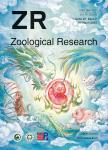Phylogenetic analysis of combined mitochondrial genome and 32 nuclear genes provides key insights into molecular systematics and historical biogeography of Asian warty newts of the genus Paramesotriton(Caudata: Salamandridae)
Phylogenetic analysis of combined mitochondrial genome and 32 nuclear genes provides key insights into molecular systematics and historical biogeography of Asian warty newts of the genus Paramesotriton(Caudata: Salamandridae)作者机构:School of Life SciencesGuizhou Normal UniversityGuiyangGuizhou 550025China School of Karst ScienceGuizhou Normal UniversityGuiyangGuizhou 550001China Guiyang Healthcare Vocational UniversityGuiyangGuizhou 550081China Zhejiang Forest Resource Monitoring CenterHangzhouZhejiang 310020China Key Laboratory of Environment Change and Resources Use in Beibu Gulf Ministry of EducationNanning Normal UniversityNanningGuangxi 530001China School of Life SciencesAnhui UniversityHefeiAnhui 230601China
出 版 物:《Zoological Research》 (动物学研究(英文))
年 卷 期:2022年第43卷第5期
页 面:787-804页
核心收录:
基 金:supported by the Guizhou Province Top Discipline Construction Program Project (Qianjiao Keyan Fa125) Postgraduate Education Innovation Programme of Guizhou Province (Qianjiaohe YJSKYJJ (2021) 091) Strategic Priority Research Program B of the Chinese Academy of Sciences (CAS)(XDB31000000) National Animal Collection Resource Center,China Application of Amphibian Natural Antioxidant Peptides as Cosmetic Raw Material Antioxidants (QKZYD 4002)
主 题:Paramesotriton Systematics Biogeography Southern China
摘 要:The Paramesotriton Chang, 1935 genus of Asian warty newts is the second most diverse genus in the family Salamandridae, currently containing 14recognized species from northern Vietnam to southwest-central and southern China. Although species of this genus have been included in previous phylogenetic studies, the origin and interspecific relationships of the genus are still not fully resolved,especially at key nodes in the phylogeny. In this study, we sequenced mitochondrial genomes and 32nuclear genes from 27 samples belonging to 14species to reconstruct the interspecific phylogenetic relationships within Paramesotriton and explore its historical biogeography in southern China. Both Bayesianinferenceandmaximum-likelihood analyses highly supported the monophyly of Paramesotriton and its two recognized species groups(P. caudopunctatus and P. chinensis groups)and further identified five hypothetical phylogenetic cryptic species. Biogeographic analyses indicated that Paramesotriton originated in southwestern China(Yunnan-Guizhou Plateau/South China) during the late Oligocene. The time of origin of Paramesotriton corresponded to the second uplift of the Himalayan/Qinghai-Xizang(Tibetan) Plateau(QTP), rapid lateral extrusion of Indochina, and formation of karst landscapes in southwestern *** component analysis(PCA), independent sample t-tests, and niche differentiation using bioclimatic variables based on locations of occurrence suggested that Paramesotriton habitat conditions in the three current regions(West, South,and East) differ significantly, with different levels of climatic niche differentiation. Species distribution model(SDM) predictions indicated that the most suitable distribution areas for the P. caudopunctatus and P. chinensis species groups are western and southern/eastern areas of southern China. This study increases our knowledge of the taxonomy,biodiversity, origin, and suitable distribution areas of the genus Paramesotriton based on phylogene



